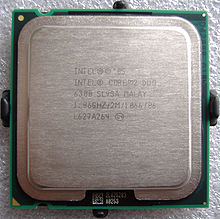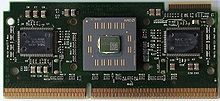
Back إكس 86 Arabic X86 Azerbaijani X86 Byelorussian X86 BE-X-OLD X86 Bulgarian X86 BS X86 Catalan ئێکس٨٦ CKB X86 Czech X86 Danish
| Designer | Intel, AMD |
|---|---|
| Bits | 16-bit, 32-bit and 64-bit |
| Introduced | 1978 (16-bit), 1985 (32-bit), 2003 (64-bit) |
| Design | CISC |
| Type | Register–memory |
| Encoding | Variable (1 to 15 bytes) |
| Branching | Condition code |
| Endianness | Little |
| Page size | 8086–i286: None i386, i486: 4 KB pages P5 Pentium: added 4 MB pages (Legacy PAE: 4 KB→2 MB) x86-64: added 1 GB pages |
| Extensions | x87, IA-32, x86-64, X86S, MMX, 3DNow!, SSE, MCA, ACPI, SSE2, NX bit, SMT, SSE3, SSSE3, SSE4, SSE4.2, AES-NI, CLMUL, SM3, SM4, RDRAND, SHA, MPX, SME, SGX, XOP, F16C, ADX, BMI, FMA, AVX, AVX2, AVX-VNNI, AVX512, AVX10, AMX, VT-x, VT-d, AMD-V, AMD-Vi, TSX, ASF, TXT, APX |
| Open | Partly. For some advanced features, x86 may require license from Intel; x86-64 may require an additional license from AMD. The Pentium Pro processor (and NetBurst) has been on the market for more than 21 years[1] and so cannot be subject to patent claims. The i686 subset of the x86 architecture is therefore fully open. The Opteron 1000 series processors have been on the market for more than 21 years[2] and so cannot be subject to patent claims. The AMD K8 subset of the x86 architecture is therefore fully open. |
| Registers | |
| General-purpose |
|
| Floating point | |



x86 (also known as 80x86[3] or the 8086 family[4]) is a family of complex instruction set computer (CISC) instruction set architectures[a] initially developed by Intel based on the 8086 microprocessor and its 8-bit-external-bus variant, the 8088. The 8086 was introduced in 1978 as a fully 16-bit extension of 8-bit Intel's 8080 microprocessor, with memory segmentation as a solution for addressing more memory than can be covered by a plain 16-bit address. The term "x86" came into being because the names of several successors to Intel's 8086 processor end in "86", including the 80186, 80286, 80386 and 80486. Colloquially, their names were "186", "286", "386" and "486".
The term is not synonymous with IBM PC compatibility, as this implies a multitude of other computer hardware. Embedded systems and general-purpose computers used x86 chips before the PC-compatible market started,[b] some of them before the IBM PC (1981) debut.
As of June 2022[update], most desktop and laptop computers sold are based on the x86 architecture family,[5] while mobile categories such as smartphones or tablets are dominated by ARM. At the high end, x86 continues to dominate computation-intensive workstation and cloud computing segments.[6]
- ^ Pryce, Dave (May 11, 1989). "80486 32-bit CPU breaks new ground in chip density and operating performance. (Intel Corp.) (product announcement) EDN" (Press release).
- ^ Swoyer, Stephen (April 24, 2003). "AMD introduces 64-bit Opteron Chip (ESJ) (news article)".
- ^ Rao, P.V.S. (2009). Computer System Architecture. Prentice-Hall of India. p. 402 (Section 19.1, The x86 family of processors). ISBN 978-81-203-3594-3.
- ^ Mhatre, Swapneel Chandrakant (2012). Microprocessors and Interfacing Techniques: For S. E. (Computer Engineering) Semester II of University of Pune. Jaico Publishing House. ISBN 978-81-8495-325-1.
- ^ Alcorn, Paul (February 9, 2022). "AMD Sets All-Time CPU Market Share Record as Intel Gains in Desktop and Notebook PCs". Tom's Hardware.
- ^ Brandon, Jonathan (April 15, 2015). "The cloud beyond x86: How old architectures are making a comeback". ICloud PE. Business Cloud News. Archived from the original on August 19, 2021. Retrieved November 23, 2020.
Despite the dominance of x86 in the datacentre it is difficult to ignore the noise vendors have been making over the past couple of years around non-x86 architectures like ARM...
Cite error: There are <ref group=lower-alpha> tags or {{efn}} templates on this page, but the references will not show without a {{reflist|group=lower-alpha}} template or {{notelist}} template (see the help page).